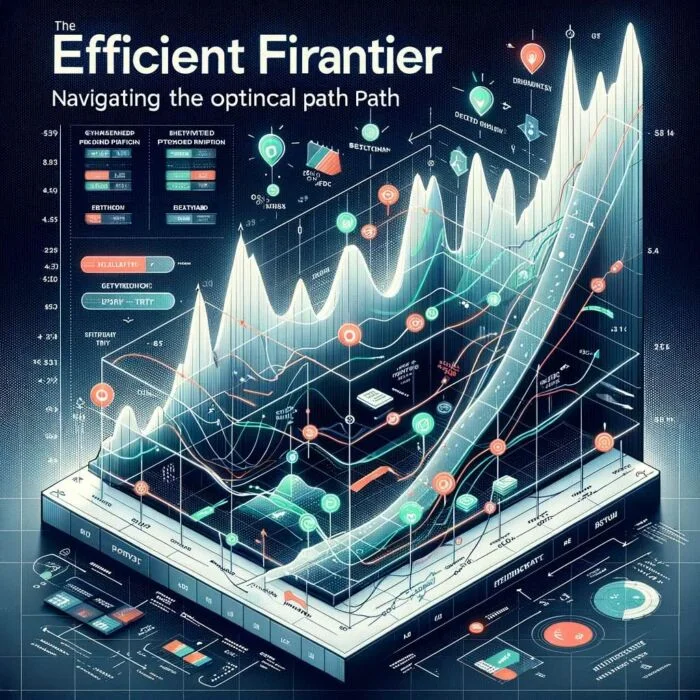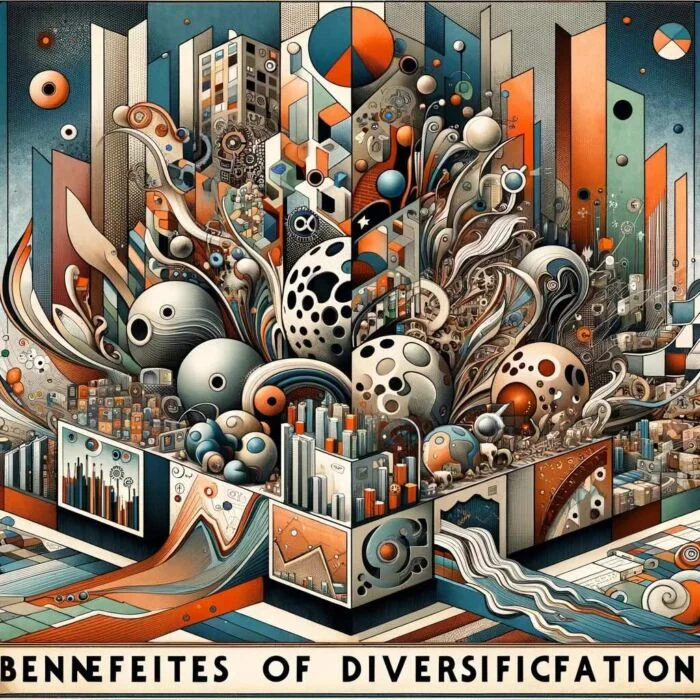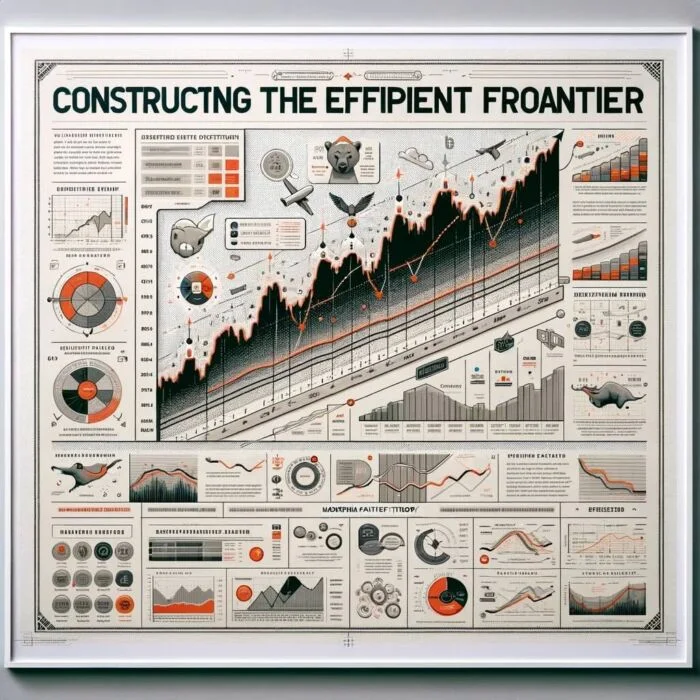Before diving into the intricacies of the revolutionary framework of portfolio selection that Harry Markowitz introduced to the finance world, it’s critical to acknowledge the pre-Markowitz era. In a time when investment strategies were largely based on gut feelings, anecdotes, or single-dimensional views of risk and reward, the finance world often treaded on thin ice. There was a palpable need for a systematic, mathematically rigorous method to approach investments – enter Harry Markowitz.

Harry Markowitz: The Pioneer of Modern Portfolio Theory
Harry M. Markowitz, a figure who would later be described as the ‘father of modern portfolio theory’, was not initially a finance scholar. Instead, he began his academic pursuits in the realm of physics, before meandering into philosophy, and eventually settling into economics. But what he brought from his diverse academic lineage was a fresh perspective. In the early 1950s, when stock selection was more of an art than science, Markowitz introduced the world to a quantifiable, scientific method of creating portfolios.
In 1952, Markowitz’s paper titled “Portfolio Selection” published in the Journal of Finance, changed the trajectory of financial research and practice. It wasn’t just another paper. It was a departure from traditional investment paradigms. It offered investors a method to balance their hunger for return with an aversion to risk, placing these two key aspects in a delicate dance.

The Modern Relevance
Fast forward to the present day, and the fingerprints of Markowitz’s insights are ubiquitous in the realm of finance. From the sophisticated algorithms of robo-advisors to the strategies employed by the world’s leading hedge funds, the essence of modern portfolio theory remains pervasive. While we now operate in a complex financial ecosystem with countless instruments and assets, the core idea of balancing risk and return remains as relevant today as it was in the 1950s. Every time an investor or portfolio manager speaks of diversification, knowingly or not, they tip their hat to Harry Markowitz.
As we delve deeper into the life, works, and monumental contributions of Harry Markowitz, it’s essential to remember the landscape before his intervention. It helps underscore the genius of his theory and why, after all these years, the art of diversification in investment remains one of the most potent tools in an investor’s arsenal.

Background of Harry Markowitz
The Formative Years: Birth and Early Life
Harry Max Markowitz was born on August 24, 1927, in Chicago to a Jewish family. From his childhood, there were inklings of a profound analytical mind, always curious and keen to understand the intricacies of how things worked. The Windy City, with its bustling streets and vibrant culture, provided a backdrop to Markowitz’s formative years. Yet, even as he grew up in the wake of The Great Depression, the broader economic circumstances of the time undoubtedly played a subconscious role in shaping his later interests.
The Crucible of Academia: Educational Endeavors
Markowitz’s journey in higher education began at the University of Chicago, a hub of pioneering research and academic rigor. He initially pursued philosophy, studying under the guidance of the famous philosopher Rudolf Carnap. However, his inherent fascination with numbers and his serendipitous introduction to economics lectures led him to pivot. He pursued a Bachelor’s degree in Economics and later went on to earn a Ph.D., also in Economics, from the University of Chicago in 1955.
During his doctoral studies, Markowitz was exposed to the work of mathematical economists, notably L.J. Savage, and was influenced by Jacob Marschak, who was then the director of the Cowles Commission for Research in Economics. This intersection of mathematics and economics would later play a pivotal role in the formulation of his groundbreaking portfolio theory.

Charting New Territories: Career and Professional Life
Post-academia, Markowitz entered the professional realm, which spanned across academia, consultancy, and financial practice. In the early stages of his career, he worked at the RAND Corporation, a research institution known for its cutting-edge studies. It was during his time at RAND that he penned the revolutionary “Portfolio Selection” paper in 1952, which laid the groundwork for Modern Portfolio Theory (MPT).
Throughout his illustrious career, Markowitz held prestigious positions at various institutions. Notably, he served as an adjunct professor at the University of California, San Diego (UCSD) and later became a professor of finance at the Rady School of Management.
His contributions weren’t just limited to MPT. Markowitz’s research spanned a wide range of topics, including the “Markowitz frontier,” a method of effectively allocating assets in a portfolio, and the concept of “utility,” which is fundamental to economics and finance.
A Lifetime of Recognition: Major Achievements
For his groundbreaking work in portfolio theory, Harry Markowitz received the Sveriges Riksbank Prize in Economic Sciences in Memory of Alfred Nobel in 1990, commonly referred to as the Nobel Prize in Economics. He shared this honor with Merton Miller and William Sharpe, two other giants in the world of financial economics.
Over the decades, Markowitz has received numerous other accolades, both from academia and the financial industry. His ideas have been integrated into the core curriculum of finance courses worldwide and have shaped the foundational strategies employed by investment managers globally.
The Undying Legacy
Today, even as the financial landscape has evolved with the advent of technology, algorithmic trading, and a plethora of new financial instruments, the principles Markowitz introduced over half a century ago stand strong. From Wall Street boardrooms to academic corridors, his name is uttered with profound respect and admiration. Markowitz’s life and work stand as a testament to the power of innovative thought and the profound impact that rigorous academic research can have on real-world practices.
source: Algovibes on YouTube

The Birth of Modern Portfolio Theory (MPT)
The Landscape Preceding Modern Portfolio Theory
To truly appreciate the significance of Harry Markowitz’s groundbreaking work, one must first contextualize the financial world of the early 1950s. Investment strategies of the time were driven largely by anecdotal wisdom and fundamental analysis. While risk was recognized as an integral aspect of investment, there was no systematic way to measure, let alone diversify, said risk. Investment portfolios were often constructed based on projections of individual stock performances, without much consideration for how the combination of different assets might interact. In essence, the art of portfolio construction was akin to a puzzle with pieces that no one quite knew how to fit together.
A Paper that Redefined Investing: “Portfolio Selection”
In the midst of this milieu, Harry Markowitz, then a young doctoral student, published a seminal paper titled “Portfolio Selection” in the Journal of Finance in 1952. The paper, though heavily mathematical, was an epiphany for the finance community. It presented the idea that investment decisions should not solely be based on expected returns, but also on the risks associated with those returns.
To many, this sounded like an intuitive idea, but Markowitz’s genius lay in converting this intuition into a rigorous mathematical framework. He proposed that risk, measured as the variance (or standard deviation) of returns, could be reduced through diversification — but not just any diversification. The crux was in selecting assets whose returns weren’t perfectly correlated, meaning the price movement of one asset wouldn’t necessarily mirror another.

The Cornerstones of Modern Portfolio Theory
- Risk and Return Duality: At the heart of MPT lies the duality of risk and return. Each investment has an expected return, which can be thought of as its reward, and an associated risk. Markowitz proposed that investors could quantify this risk by the variability (standard deviation) of historical returns.
- Portfolio Diversification: Markowitz’s theory emphasized that the risk of a portfolio was not simply the weighted average of the risks of its constituent assets. Instead, the correlation between the assets played a crucial role. If two assets were perfectly positively correlated, there was no risk reduction benefit from combining them. Conversely, two assets that were perfectly negatively correlated could, in theory, eliminate risk altogether.
- Efficient Frontier: Through his theory, Markowitz introduced the concept of the ‘efficient frontier’. This frontier represents a set of portfolios that offer the highest expected return for a given level of risk or, equivalently, the lowest risk for a given level of expected return. Portfolios that lie below the efficient frontier are considered sub-optimal because they do not provide enough return for the level of risk.
- Investor Utility: Recognizing that investors have different risk tolerances, Markowitz incorporated the concept of utility. Essentially, each investor’s unique risk-return trade-off preference could be represented by a utility curve, and the optimal portfolio for an individual investor would be where this curve touched the efficient frontier.
The Revolutionary Implications
Markowitz’s MPT was more than just a theory; it was a paradigm shift. For the first time, investors had a methodical, quantitative way to design portfolios. It debunked the long-held belief that maximizing returns was the sole objective. Instead, it emphasized the importance of balancing returns with risks, advocating for a more holistic approach to investing.
Furthermore, the theory empowered investors to move beyond gut feelings and individual stock analysis. It provided a clear blueprint on how assets could be combined to achieve desired risk-return objectives.
source: Investors Trading Academy on YouTube
Key Concepts of Markowitz’s Portfolio Theory

Risk and Return: The Dual Pillars of Investment
Expected Return:
- Definition: The anticipated profit or loss an investor can expect from an investment, often calculated as a weighted average of possible returns, each weighted by its respective probability.
- Importance: It provides a baseline against which potential investments can be evaluated. An asset’s desirability isn’t solely based on its expected return but in conjunction with its risk.
- Calculation: Typically, historical data is used to compute an average return, but future projections or expert opinions might also be taken into account.
- In MPT: Every asset or security has an associated expected return, which influences its placement on a risk-return graph.
Standard Deviation (Risk):
- Definition: A statistical measure representing the dispersion or spread of a set of values. In finance, it measures the volatility or riskiness of an asset’s returns.
- Importance: It provides a quantifiable measure of an asset’s risk. Assets with higher standard deviations are considered riskier since their returns can vary significantly from their expected return.
- In MPT: The standard deviation is plotted against the expected return to create a risk-return landscape of potential investments.

Efficient Frontier: Navigating the Optimal Path
- Definition: A curve on a graph that represents portfolios that maximize expected return for a given level of risk or minimize risk for a given expected return.
- Construction: It is derived by plotting all possible combinations of risky assets on a graph, with the x-axis representing risk (standard deviation) and the y-axis representing expected return.
- Significance: Portfolios on the efficient frontier are “optimal” because no other portfolio offers a higher expected return for the same level of risk or a lower risk for the same expected return.
- Implications: Investors should aim to have their portfolios on this frontier, adapting their asset allocations based on their unique risk-return preferences.
Diversification: The Art of Spreading Risk
- Definition: The practice of distributing investments among various financial instruments, industries, or categories to reduce exposure to any single asset or risk.
- Principle: “Don’t put all your eggs in one basket.” By diversifying investments, the negative performance of some investments can be cushioned by the positive performance of others.
- In MPT: Diversification isn’t just about holding different assets; it’s about holding assets whose returns aren’t perfectly correlated, hence maximizing the risk-reducing benefits.
- Limitations: While diversification can reduce unsystematic risk (risks associated with a particular industry or company), it cannot eliminate systematic risk (risks that affect the entire market or economy).
Correlation: Measuring Synchronized Movements
- Definition: A statistical measure that describes the degree to which the returns of two assets move in relation to each other.
- Scale: Correlation coefficients range between -1 and 1. A correlation of 1 means the assets move perfectly together, -1 means they move in opposite directions, and 0 means no correlation.
- Implication in Diversification: Assets with a correlation coefficient close to zero or negative are especially valuable for diversification. Combining assets with low or negative correlations can reduce the overall risk of a portfolio more than what would be achieved by merely averaging the risks of individual assets.
- In MPT: Understanding correlations is crucial when constructing a portfolio on the efficient frontier. By combining assets with different correlations, one can achieve a desired level of risk and return that wouldn’t be possible with individual assets.
Markowitz’s Portfolio Theory provided investors with a rigorous, mathematically-founded framework to navigate the complex world of investments. It shifted the narrative from a singular focus on returns to a dual emphasis on both risk and return, emphasizing the importance of diversification and the interplay between different assets. This approach, even decades later, continues to be the cornerstone of investment strategy and portfolio management.
source: The Plain Bagel on YouTube

Benefits of Diversification
Diversification, often encapsulated by the adage “Don’t put all your eggs in one basket,” has been a cornerstone of investment strategy for generations. By spreading investments across various assets or asset classes, an investor can mitigate certain risks and create a more resilient portfolio. Let’s delve deeper into the numerous benefits that diversification offers.
Reduction of Unsystematic Risk
Understanding Unsystematic Risk:
- Also known as idiosyncratic risk, company-specific risk, or diversifiable risk, unsystematic risk pertains to the uncertainties inherent to an individual company or industry. These can range from company scandals, changes in management, production snags, or even regulatory changes that impact a specific sector.
Diversification’s Role:
- By holding a diverse set of assets, the adverse performance of a single asset, or a group of assets from the same industry, has a reduced impact on the overall portfolio.
- As more assets are added to a portfolio, and especially assets that are not perfectly correlated, the impact of individual asset volatility diminishes, thereby reducing unsystematic risk.
Practical Implications:
- Even if an investor believes strongly in the potential of a particular company or sector, it’s prudent to diversify to protect against unforeseen company-specific downturns.
- As more assets are added, however, the marginal benefit of each additional asset in reducing unsystematic risk diminishes. There’s a point of “optimal diversification” beyond which adding more assets might not significantly reduce risk further.

Achieving a More Stable Portfolio Return
- Smoothing Out Returns:
- Diversification can help smooth out the returns of a portfolio. While some assets may underperform, others may outperform, potentially leading to a more consistent and predictable portfolio return over time.
- Reducing Volatility:
- The overall volatility (standard deviation of returns) of a well-diversified portfolio is typically lower than the weighted average volatilities of its individual assets, thanks to the interplay of correlations.
- Behavioral Finance Angle:
- Investors are often influenced by cognitive biases. A more stable portfolio return can help keep investor emotions in check, reducing the likelihood of making impulsive decisions during market highs or lows.
Protection Against Adverse Events in Specific Sectors or Stocks
- Economic and Sectoral Shifts:
- Economic landscapes are in constant flux. Industries that flourish in one decade might stagnate in another due to technological advancements, regulatory changes, or shifts in consumer preferences.
- Unexpected Events:
- Events like technological disruptions, geopolitical tensions, lawsuits, or sudden regulatory changes can have a dramatic impact on specific companies or entire sectors.
- The Safety Net of Diversification:
- A diversified portfolio, spread across multiple sectors or even countries, can act as a safety net. When one sector is hit hard, the negative returns might be offset by stable or positive returns in other sectors.
- For instance, during a tech industry downturn, holdings in more traditional sectors like utilities or consumer staples might buffer the portfolio’s performance.
- Global Diversification:
- Extending the principle of diversification to a global scale, investing across different countries and regions offers protection against country-specific risks such as political instability, economic downturns, or currency devaluations in any one nation.
Diversification stands as a foundational pillar of wise investment strategy. While it doesn’t guarantee against loss, it provides a powerful tool for managing risk, harnessing the benefits of different assets, and ensuring that the portfolio is well-equipped to weather the unpredictabilities of the financial markets. Through diversification, an investor can create a resilient portfolio, better poised to achieve long-term financial objectives.
source: The Plain Bagel on YouTube

Critics and Limitations of Modern Portfolio Theory (MPT)
Modern Portfolio Theory (MPT) has profoundly shaped the field of finance and investment, offering a mathematically rigorous framework for portfolio optimization. However, like any theoretical model, MPT has its assumptions and critics. Let’s explore some of these criticisms and the inherent limitations of the theory.
Assumptions Under the Microscope
Normality of Returns:
- Assumption: MPT often assumes that asset returns are normally distributed. This assumption simplifies the mathematical models and calculations.
- Criticism: In reality, financial markets have displayed non-normalities like “fat tails” (kurtosis) and “skewness.” These statistical properties imply that extreme market events (both upswings and downturns) occur more frequently than a normal distribution would predict.
- Implication: Relying solely on MPT under the presumption of normality might lead to underestimation of extreme risks.
Rational Investors:
- Assumption: MPT assumes that investors are rational, aiming to maximize their wealth and making choices based on logical and full analysis.
- Criticism: Numerous studies and real-world events have showcased that investors often act irrationally due to cognitive biases, herd mentality, or emotional reactions.
- Implication: The existence of irrational behavior can lead to asset mispricings, bubbles, and crashes, which deviate from MPT predictions.
Fixed Correlation Coefficients:
- Assumption: MPT assumes that the correlation between assets remains relatively stable over time.
- Criticism: In reality, correlations between assets can change, especially during market crises. For instance, during significant downturns, many assets that previously exhibited low correlation might suddenly become highly correlated, undermining diversification benefits.
- Implication: This dynamic nature of correlation can impact the actual risk of diversified portfolios, making them potentially riskier than MPT models predict.

The Rise of Behavioral Finance
Defining Behavioral Finance:
- An interdisciplinary field that merges psychological insights with financial theory to understand how individual and market behaviors deviate from classical theoretical expectations.
Challenges to MPT:
- Market Bubbles and Crashes: Behavioral finance provides explanations for phenomena like stock market bubbles and subsequent crashes, arguing that they can arise from collective psychological factors and can’t be fully explained by MPT.
- Mental Accounting: Investors often treat money differently depending on its source or intended use, which can influence their investment decisions in non-optimal ways.
- Overconfidence: Investors might overestimate their knowledge or abilities, leading them to take on more risk than they realize.
- Loss Aversion: Investors tend to feel the pain of a loss more acutely than the pleasure of a similar gain, which can lead to risk-averse behavior that deviates from optimal strategies.
Implications for MPT:
- If markets aren’t always efficient and if investor behavior isn’t always rational, then the foundational premises of MPT come under scrutiny.
- While MPT provides a valuable baseline framework, understanding the insights from behavioral finance is crucial for a holistic approach to investment.
While Modern Portfolio Theory remains a cornerstone in finance and investment education, it is essential to understand its limitations and the assumptions it rests upon. Over time, as financial markets evolve and academic research advances, the synthesis of traditional portfolio theories like MPT with insights from fields like behavioral finance will likely lead to even more comprehensive and nuanced investment strategies.
source: Douglas Goldstein on YouTube

Markowitz’s Legacy in the Investment World
Harry Markowitz’s pioneering work on portfolio selection fundamentally altered the landscape of finance and investment. Over seven decades after the publication of his seminal paper, the reverberations of his concepts are still distinctly felt across the investment realm. Here’s an exploration of Markowitz’s lasting legacy.
Nobel Prize in Economic Sciences in 1990
- Recognition of a Groundbreaking Contribution:
- In 1990, Harry Markowitz was jointly awarded the Sveriges Riksbank Prize in Economic Sciences in Memory of Alfred Nobel. He shared this honor with Merton Miller and William Sharpe, who made significant contributions to the theory of financial economics.
- Cementing the Importance of MPT:
- The Nobel Committee’s decision underlined the groundbreaking nature of Markowitz’s 1952 paper “Portfolio Selection.” His work laid the mathematical foundation for understanding the trade-off between risk and return in portfolio management.
- Beyond the Nobel:
- Markowitz’s recognition isn’t limited to the Nobel Prize. His theories have been widely accepted and integrated into mainstream financial education and practice, making him a luminary figure in the realm of financial economics.
Modern Investment Tools and MPT
- Rise of Robo-Advisors:
- With technological advancements and the digital transformation of financial services, robo-advisors have emerged as popular tools for individual investors. These automated platforms use algorithms to suggest or make investment decisions on behalf of clients.
- MPT’s Influence on Robo-Advisors:
- The algorithms behind many robo-advisors are rooted in the principles of Modern Portfolio Theory. They consider the expected returns, variances, and covariances of various assets to optimize portfolio allocations.
- By determining an investor’s risk tolerance—often through a questionnaire—robo-advisors apply MPT to tailor a diversified portfolio aiming to maximize returns for that specific level of risk.
- Democratizing Finance:
- Robo-advisors, with their relatively low fees and ease of access, have democratized financial planning. This means that Markowitz’s principles, through their implementation in robo-advisors, have become accessible to a broader swath of the population, not just to high-net-worth individuals or institutional investors.
Continued Relevance in Portfolio Management and Financial Education
- Financial Curriculum:
- Markowitz’s Modern Portfolio Theory forms an essential part of finance and investment curricula worldwide. Whether in undergraduate finance courses, MBA programs, or professional certifications like the CFA, MPT’s principles are foundational.
- In Professional Practice:
- Portfolio managers, investment advisors, and institutional investors continue to use the principles of MPT, either in its original form or in conjunction with other theories and tools, to guide investment decisions and strategies.
- MPT’s Adaptability:
- Over the years, the theory has been refined, expanded, and adapted to changing market conditions. New asset classes, changing market dynamics, and global interconnectedness have led to evolved versions of MPT, demonstrating its enduring flexibility and relevance.
- A Basis for Further Exploration:
- While some critics highlight the limitations of MPT, it’s worth noting that Markowitz’s theory provides a foundational framework. It has sparked further research, debate, and exploration in the realm of financial economics, acting as a cornerstone upon which new theories and ideas are built.
Harry Markowitz’s influence on the investment world is both profound and enduring. His fusion of economic insight with mathematical rigor provided the investment community with a systematic and quantifiable approach to risk and return. The lasting impact of his work—evident in everything from elite financial institutions to the digital tools available to everyday investors—stands as a testament to the revolutionary nature of his ideas and their enduring relevance in the complex world of finance.
source: Study Practically on YouTube

Case Study: Practical Application of Markowitz’s Portfolio Theory
Modern Portfolio Theory (MPT), pioneered by Harry Markowitz, has transformed the way institutional and individual investors approach portfolio construction. By emphasizing the importance of diversification and the trade-off between risk and return, MPT provides a framework for creating optimal portfolios. Let’s explore a real-world application of MPT through a case study of a fictional investment firm, “OptimaWealth.”
Background:
OptimaWealth is a medium-sized investment firm catering to high-net-worth individuals. With a growing client base, they aimed to design a new suite of investment portfolios. Their goal was to offer a range of options, each optimized for a different risk tolerance level.
1. Understanding Client Needs:
Before applying MPT, OptimaWealth surveyed their clients to understand their risk appetites. Based on feedback, they identified three main investor categories:
- Conservative: Primarily seeking capital preservation.
- Balanced: Seeking a mix of income and capital appreciation.
- Aggressive: Seeking high capital appreciation.
2. Asset Identification & Return Estimation:
OptimaWealth then shortlisted a mix of assets: equities from various sectors and regions, government and corporate bonds, commodities, real estate, and cash equivalents.
For each asset, historical data was used to calculate:
- Expected returns based on past performance and future projections.
- The standard deviation (volatility) as a measure of risk.
3. Correlation Analysis:
Understanding how different assets move in relation to each other is crucial. OptimaWealth analyzed the correlation coefficients between asset pairs. Assets with low or negative correlations were especially valuable, as they could be combined to reduce portfolio volatility.

4. Constructing the Efficient Frontier:
Using MPT’s mathematical framework and optimization tools, OptimaWealth created a set of portfolios that offered the highest expected return for a given level of risk. Plotting these portfolios on a graph (with return on the Y-axis and risk on the X-axis) resulted in the “efficient frontier” – a curve showcasing the optimal portfolios.
5. Portfolio Recommendations:
- Conservative Portfolio: For risk-averse clients, the portfolio was heavily weighted towards government bonds, high-grade corporate bonds, and cash equivalents. Equities constituted a minor portion, focusing on blue-chip and dividend-paying stocks.
- Balanced Portfolio: This portfolio had a roughly equal mix of equities and bonds. It incorporated some growth stocks and international equities for diversification, complemented by bonds and real estate investments for steady income.
- Aggressive Portfolio: Dominated by equities, especially in sectors like technology and emerging markets. There was a smaller allocation to corporate bonds and commodities, aiming for high growth potential.
6. Ongoing Review and Rebalancing:
Markowitz’s theory isn’t a set-it-and-forget-it approach. OptimaWealth set up quarterly reviews to ensure each portfolio’s composition remained optimal. Adjustments were made based on market conditions, asset performances, and any shifts in the efficient frontier.
Outcome:
Following the application of MPT principles, OptimaWealth’s new portfolio suite was well-received. Clients appreciated the systematic approach, and the firm saw improved portfolio performances with better risk-adjusted returns.
This case study underscores the practical utility of Harry Markowitz’s groundbreaking theory. By quantifying risk and emphasizing diversification, MPT enables investment professionals to craft portfolios aligned with investors’ goals and risk tolerances. As demonstrated by OptimaWealth, a methodical application of MPT principles can lead to optimized investment outcomes in real-world scenarios.
source: Research Affiliates on YouTube

12 Frequently Asked Questions About Harry Markowitz and the Art of Diversification in Investment
Who was Harry Markowitz and why is he important in investing?
Harry Markowitz was an American economist who revolutionized modern finance with his 1952 paper “Portfolio Selection.” He introduced Modern Portfolio Theory (MPT), a quantitative framework that showed how investors can use diversification to balance risk and return, transforming portfolio management from intuition to science.
What is Modern Portfolio Theory (MPT) in simple terms?
Modern Portfolio Theory is a mathematical approach to building portfolios that maximize expected return for a given level of risk. Instead of analyzing assets in isolation, MPT looks at how different assets interact, using variance and correlation to find optimal combinations that form the “efficient frontier.”
How did investing work before Markowitz’s contributions?
Before Markowitz, investing was largely driven by intuition, anecdotal wisdom, and single-asset analysis. There was no rigorous framework for quantifying or managing portfolio risk. Investors focused on individual stock performance without fully considering how assets behaved in combination.
What role did diversification play in Markowitz’s theory?
Diversification is at the heart of MPT. Markowitz demonstrated that combining assets with low or negative correlations can reduce overall portfolio volatility without sacrificing expected returns. This insight led to the famous notion that diversification is the only free lunch in finance.
What is the efficient frontier and why does it matter?
The efficient frontier is a curve representing portfolios that offer the highest return for each level of risk or the lowest risk for each level of return. Portfolios below this curve are suboptimal. By operating on the efficient frontier, investors can make rational, data-driven asset allocation decisions aligned with their risk tolerance.
How is risk measured in Modern Portfolio Theory?
Markowitz used variance and standard deviation to quantify risk—the variability of returns over time. By analyzing how individual assets contribute to portfolio variance and how they correlate with one another, investors can construct portfolios with more predictable risk–return profiles.
How has Markowitz’s work influenced modern investing tools like robo-advisors?
Many robo-advisors use algorithms rooted in MPT. By assessing an investor’s risk tolerance and analyzing asset correlations, these platforms automatically create diversified portfolios along the efficient frontier, making sophisticated portfolio optimization accessible to everyday investors.
What are some limitations or criticisms of Modern Portfolio Theory?
Critics point to several assumptions: normally distributed returns, stable correlations, and rational investor behavior. In reality, markets display fat tails, correlations spike during crises, and behavioral biases influence decisions. These factors can cause real-world portfolios to diverge from MPT’s theoretical predictions.
How has behavioral finance challenged Markowitz’s ideas?
Behavioral finance highlights how irrational behaviors—like overconfidence, loss aversion, or herd mentality—can drive markets away from rational equilibrium. While MPT assumes rational investors, behavioral insights explain bubbles, crashes, and anomalies that MPT alone cannot fully address.
How is Modern Portfolio Theory applied in practice today?
Financial institutions, portfolio managers, and advisors use MPT principles to structure diversified portfolios across asset classes, sectors, and geographies. Asset allocation models, risk-parity frameworks, and multi-factor investing often build upon MPT’s foundation, sometimes integrating more sophisticated risk measures.
What is Harry Markowitz’s legacy in finance?
Markowitz’s legacy is profound. His ideas reshaped portfolio management, inspired generations of financial research, and remain integral to both academic curricula and professional practice. His emphasis on risk–return trade-offs and diversification underpins modern investing strategies worldwide.
How does diversification protect investors during market downturns?
Diversification spreads exposure across assets that behave differently under stress. When one sector or region underperforms, others may remain stable or outperform, softening the blow of adverse events. While it doesn’t eliminate systemic risk, it reduces unsystematic risk and stabilizes portfolio returns over time.
Conclusion: Legacy of Harry Markowitz and the Pillars of Diversification
In the intricate labyrinth of financial markets, few theories have withstood the test of time and practice as resoundingly as Harry Markowitz’s Modern Portfolio Theory (MPT). Not merely an academic construct, MPT emerged as a touchstone for millions of investors seeking to navigate the tumultuous waters of global markets.
A Timeless Contribution:
At the heart of Markowitz’s revolutionary idea was a fundamental insight: Investors should not merely chase returns but consider the trade-off between risk and return. While this might seem intuitive now, it was nothing short of groundbreaking in the 1950s. Before Markowitz, the finance world’s focus was heavily skewed towards analyzing individual assets rather than the holistic view of a portfolio. His reframing of the investment conversation around this holistic view forever changed the art and science of investing.

Diversification: The Only Free Lunch in Finance
Often touted as the only “free lunch” in finance, diversification has become an unassailable tenet of investment wisdom. This idea is rooted deeply in MPT. By spreading investments across various assets that are not perfectly correlated, investors can potentially achieve a desired return with lower risk.
Diversification does not guarantee against loss, but it offers a safety net, cushioning the impact of unfavorable events affecting specific sectors, regions, or asset classes. In a world of unforeseen geopolitical events, sudden market shocks, and evolving economic landscapes, the merit of diversification is more pronounced than ever.
Modern Iterations and Enduring Principles:
While the financial world has seen significant evolution since Markowitz’s time—with the advent of new financial instruments, the rise of algorithmic trading, and the integration of behavioral finance—the core tenets of MPT remain intact. Today’s robo-advisors, algorithm-driven portfolio managers, and even traditional asset managers leverage MPT principles, either in their pure form or in conjunction with other theories.
Moreover, as our case study of OptimaWealth illustrated, the theory is not just a relic of academic finance; it’s a living, breathing part of today’s investment decision-making process.
Education, Practice, and Beyond:
MPT’s influence isn’t restricted to portfolio construction alone. It is a cornerstone of financial education. Students and professionals worldwide are introduced to Markowitz’s efficient frontier, learning the intricate dance between risk and return.
In professional circles, be it in a Wall Street skyscraper’s hallowed halls or a financial planner’s suburban office, the echoes of Markowitz’s work are palpable. The conversations about risk, return, correlation, and, most importantly, diversification, owe much to his foundational work.
In Retrospect:
In wrapping up our journey through Markowitz’s legacy, one might argue that his true genius lay not in the intricate mathematics or the elegant curves of the efficient frontier. Instead, it was in his vision of a disciplined, systematic approach to investing—an approach where decisions are rooted in a balance between ambition (return) and caution (risk).
As financial markets continue to evolve, and as new theories emerge and fade, the indelible mark left by Harry Markowitz remains. His understanding of diversification, embodied in the Modern Portfolio Theory, will continue to play a pivotal role in safeguarding and optimizing investor wealth for generations to come.

Further Reading & Resources:
Given the depth and range of the topics covered, a detailed exploration would inevitably draw from a variety of seminal works. Below is a comprehensive list of key academic papers, books, and other resources that would provide a rich foundation for an article on Harry Markowitz and the essence of diversification in investment:
1. Academic Papers:
- Markowitz, H. (1952). “Portfolio Selection.” The Journal of Finance, 7(1), 77-91.
- The foundational paper where Markowitz introduced the concept of an efficient frontier and laid out the mathematics of diversification.
- Markowitz, H. (1959). “Portfolio Selection: Efficient Diversification of Investments.” Yale University Press.
- An expansion of his earlier 1952 paper, this work delves deeper into the nuances of portfolio selection.
2. Books:
- Markowitz, H. (1991). “The Early History of Portfolio Theory: 1600-1960.” Financial Analysts Journal, 47(5), 5-16.
- A retrospective look by Markowitz himself at the historical development of portfolio theory.
- Elton, E. J., & Gruber, M. J. (1995). “Modern Portfolio Theory and Investment Analysis.” John Wiley & Sons.
- An essential text that expands upon Markowitz’s work, providing a comprehensive examination of portfolio theory’s applications and implications.
- Sharpe, W. F., Alexander, G. J., & Bailey, J. V. (1999). “Investments.” Prentice Hall.
- A foundational textbook in finance that dedicates significant sections to Markowitz’s MPT and its practical applications.
3. Other Academic Resources:
- Tobin, J. (1958). “Liquidity Preference as Behavior Towards Risk.” The Review of Economic Studies, 25(2), 65-86.
- This paper expands on Markowitz’s theories by introducing the concept of a “separation theorem” in portfolio selection.
4. Contemporary Reviews and Discussions:
- Goetzmann, W. N., & Kumar, A. (2008). “Equity portfolio diversification.” Review of Finance, 12(3), 433-463.
- A modern take on the diversification principles laid out by Markowitz, examining their relevance in contemporary markets.
- Perold, A. F. (2004). “The Capital Asset Pricing Model.” Journal of Economic Perspectives, 18(3), 3-24.
- While primarily about the CAPM, this paper offers a review of the foundational ideas set by Markowitz that led to its development.
Important Information
Comprehensive Investment Disclaimer:
All content provided on this website (including but not limited to portfolio ideas, fund analyses, investment strategies, commentary on market conditions, and discussions regarding leverage) is strictly for educational, informational, and illustrative purposes only. The information does not constitute financial, investment, tax, accounting, or legal advice. Opinions, strategies, and ideas presented herein represent personal perspectives, are based on independent research and publicly available information, and do not necessarily reflect the views or official positions of any third-party organizations, institutions, or affiliates.
Investing in financial markets inherently carries substantial risks, including but not limited to market volatility, economic uncertainties, geopolitical developments, and liquidity risks. You must be fully aware that there is always the potential for partial or total loss of your principal investment. Additionally, the use of leverage or leveraged financial products significantly increases risk exposure by amplifying both potential gains and potential losses, and thus is not appropriate or advisable for all investors. Using leverage may result in losing more than your initial invested capital, incurring margin calls, experiencing substantial interest costs, or suffering severe financial distress.
Past performance indicators, including historical data, backtesting results, and hypothetical scenarios, should never be viewed as guarantees or reliable predictions of future performance. Any examples provided are purely hypothetical and intended only for illustration purposes. Performance benchmarks, such as market indexes mentioned on this site, are theoretical and are not directly investable. While diligent efforts are made to provide accurate and current information, “Picture Perfect Portfolios” does not warrant, represent, or guarantee the accuracy, completeness, or timeliness of any information provided. Errors, inaccuracies, or outdated information may exist.
Users of this website are strongly encouraged to independently verify all information, conduct comprehensive research and due diligence, and engage with qualified financial, investment, tax, or legal professionals before making any investment or financial decisions. The responsibility for making informed investment decisions rests entirely with the individual. “Picture Perfect Portfolios” explicitly disclaims all liability for any direct, indirect, incidental, special, consequential, or other losses or damages incurred, financial or otherwise, arising out of reliance upon, or use of, any content or information presented on this website.
By accessing, reading, and utilizing the content on this website, you expressly acknowledge, understand, accept, and agree to abide by these terms and conditions. Please consult the full and detailed disclaimer available elsewhere on this website for further clarification and additional important disclosures. Read the complete disclaimer here.





